Key takeaways:
- A systematic approach to organizing project files enhances efficiency and prevents chaos during film production.
- Key components of project files include a comprehensive project overview, contracts, and a clearly defined production schedule.
- Implementing clear file naming conventions and color-coding aids in quick retrieval and fosters collaboration among team members.
- Regularly reviewing and backing up files, along with creating a ‘readme’ document, helps maintain organization and safeguards against data loss.
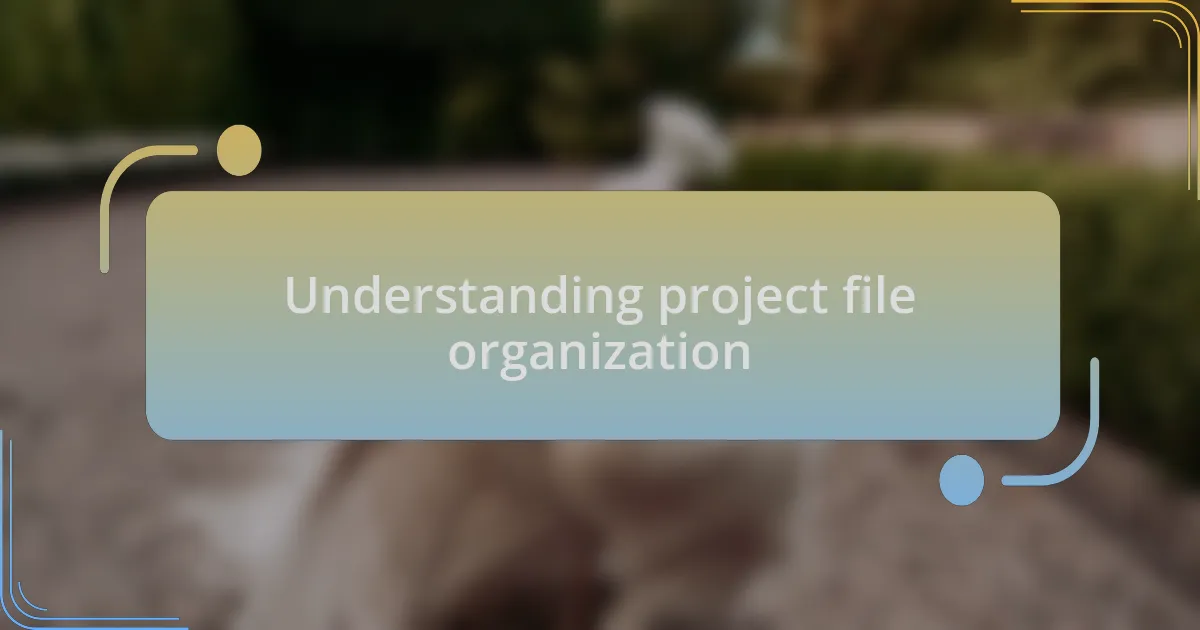
Understanding project file organization
When it comes to organizing project files, clarity is paramount. I remember a chaotic shoot where misplaced files caused delays, stirring up a whirlwind of frustration. This taught me that a systematic approach is not just beneficial; it’s essential for smooth operations in film production.
Organizing files also involves anticipating future needs. Have you ever found yourself searching for a particular script or edit and wasted precious hours? I’ve been there, and it’s a sinking feeling. By categorizing files into clear folders—like pre-production, production, and post-production—I’ve found that I can retrieve anything I need in an instant, saving time and sanity.
It’s not just about structure; it’s about creating an emotional connection to the organization. Each file represents hours of creative effort and collaboration, so I’ve learned to label everything thoughtfully and consistently. This adds a personal touch to the organization, making me feel more connected to the project and the team, ensuring that every member knows that their contributions matter.
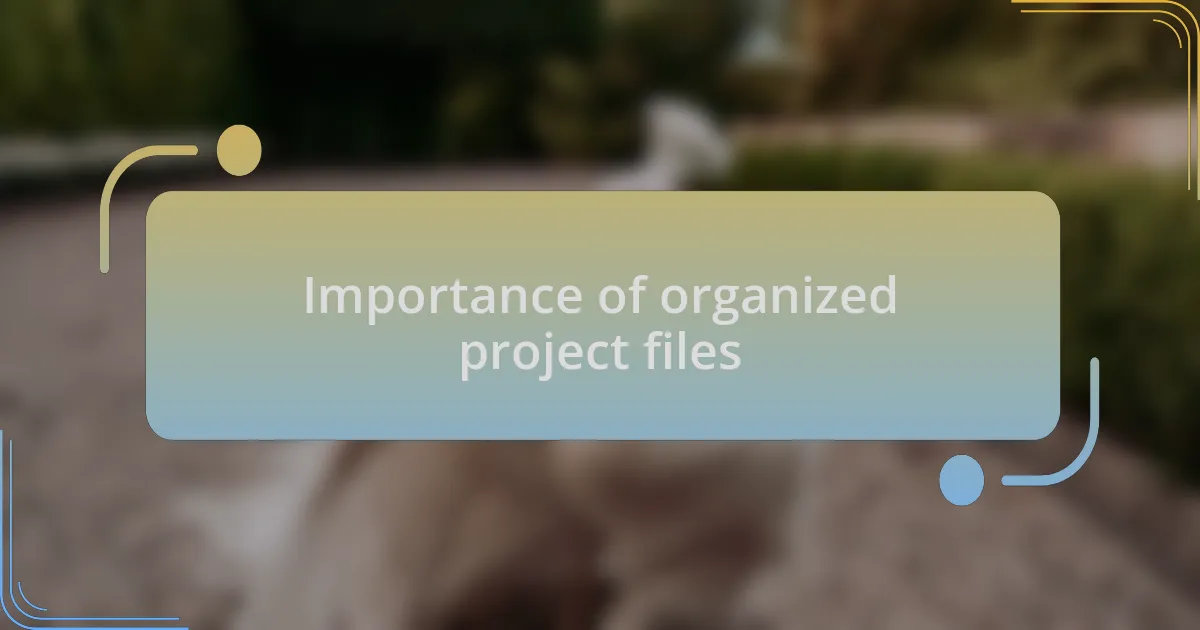
Importance of organized project files
The importance of organized project files cannot be overstated. I once worked on a project where we lost a crucial location agreement because it was buried under layers of disorganized documents. The sheer panic that set in as we scrambled to locate that one piece of paper was a wake-up call. I realized then that effective organization is the backbone of any successful film production—without it, projects can swiftly descend into chaos.
Consider the pace of film production. Things move quickly, and everyone is trying to balance multiple tasks. When I implemented a digital filing system, it felt like unlocking a treasure chest. No more rifling through stacks of paper; instead, files were just a search away. This change not only improved our workflow but also boosted morale. Knowing that we could all quickly access the right material meant less stress and more creativity flowed among the team.
Moreover, organized project files foster collaboration. I remember a time when our team relied heavily on shared folders to track progress. It was a game-changer. Everyone felt empowered to contribute, knowing they could easily find scripts, shot lists, and notes. This sense of clarity cultivated an environment where ideas thrived. Have you considered how your filing system influences your team’s creativity? The organization isn’t just practical—it builds a culture of collaboration that can elevate a project to greater heights.
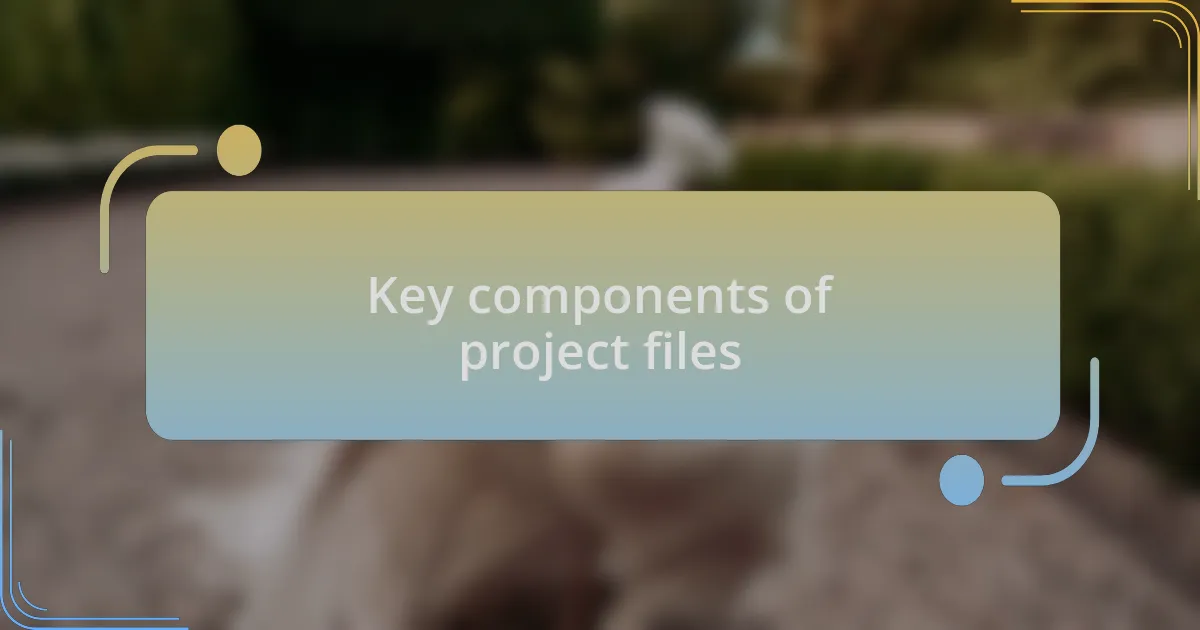
Key components of project files
When it comes to project files, the key components are essential documents that form the backbone of the production. First and foremost, I always include a comprehensive project overview. This one-pager summarizes the film’s concept, budget, and timeline, creating a quick reference point for everyone involved. It’s like a roadmap that guides the entire team and keeps everyone aligned toward a common goal. Have you ever tried to steer a ship without a map? It’s challenging!
Equally important are contracts and agreements that support the legalities of the project. I learned this the hard way when we faced unexpected changes in our cast, and having clear agreements on hand saved us countless headaches. Organized contracts ensure that everyone knows their rights and responsibilities, which helps maintain harmony on set. After all, trust is built on clarity, right?
Another critical component is the production schedule. For me, breaking down each phase of filming—and who’s responsible for what—creates a rhythm that everyone can follow. I once faced a debilitating delay because a key crew member was unsure of the shooting schedule. After that experience, I realized that a well-structured timeline not only enhances accountability but also helps prevent miscommunication. Can you imagine the stress of losing precious shooting days? It’s a nightmare I won’t soon forget.

File naming conventions and practices
When it comes to file naming conventions, clarity is crucial. I typically use a straightforward format that includes the project name, document type, and date, separated by underscores. For instance, “FilmTitleScript2023-10-20.doc” tells me exactly what I’m looking at without any confusion. Have you ever opened a document and wasted precious minutes figuring out its contents? Those moments can add up, especially during a tight production schedule.
I also prioritize consistency in naming practices across all project files. Whether it’s scripts, shot lists, or budget spreadsheets, using the same systematic approach helps everyone on the team stay organized. I remember a time when a fellow crew member named their files sporadically; it created chaos during editing. A little consistency can go a long way in maintaining order, and it fosters teamwork by ensuring everyone is on the same page.
Furthermore, I advocate for avoiding special characters and spaces in file names. I learned this lesson when a crucial file became inaccessible due to a naming error. Sticking to alphanumeric characters ensures compatibility across various systems. Isn’t it frustrating when technology fails us over something as simple as a file name? Adhering to this practice has saved me from a lot of unnecessary headaches and allowed my workflow to remain seamless.
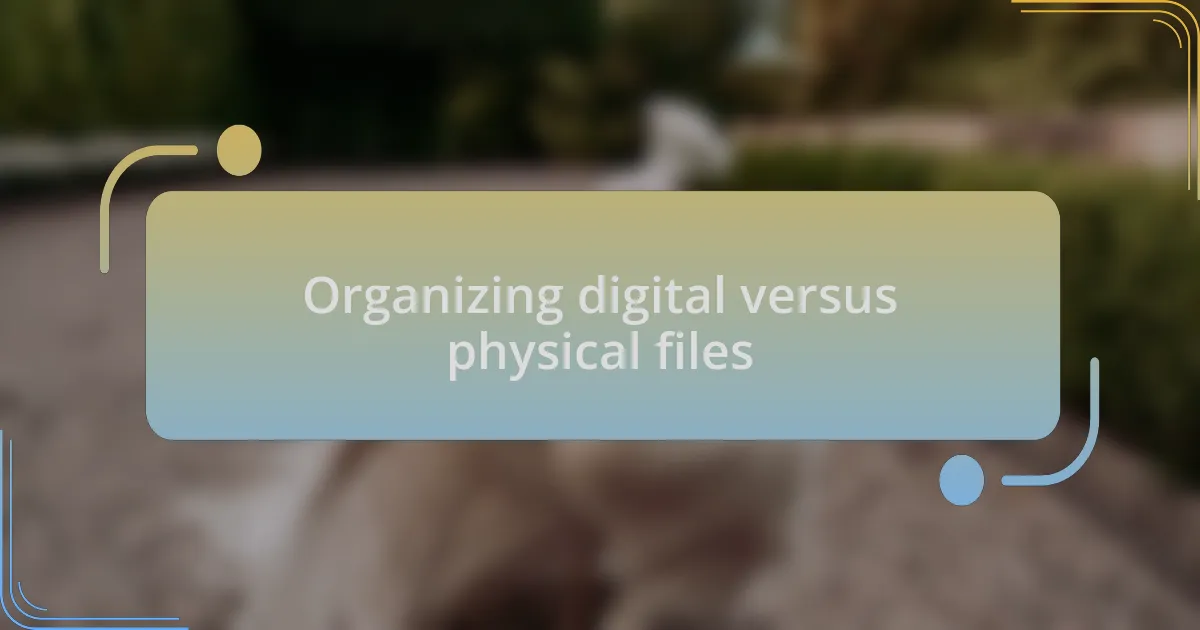
Organizing digital versus physical files
Organizing digital files and physical files serves distinct purposes, each offering unique advantages in the realm of film production. I often find that digital files provide convenience and ease of access, particularly when working remotely or on tight schedules. There have been times when I’ve had a script draft on my laptop that I could pull up in seconds, allowing for real-time collaboration. On the other hand, I cherish the tactile experience of holding physical copies of storyboards and shot lists. There’s something satisfying about flipping through pages, marking them up with a red pen, and feeling the weight of the project in my hands.
When it comes to storage, digital files allow for a level of organization that physical files can struggle to match. With cloud services, I can tag files with keywords and search for them in an instant. I vividly remember a shoot where I needed to find an archived reference video. Instead of sifting through boxes in a dusty office, I quickly located it on my drive. Yet, despite these conveniences, I’ve encountered moments when technology failed me, like sudden crashes that left me worried about lost footage. This makes me appreciate having backup physical copies, even if they take up space.
Ultimately, the best approach often involves blending both methods. I keep my essential documents both digitally lodged in organized folders and printed for easy reference. This strategy reduces stress; I feel reassured knowing I can access critical materials quickly, whether I’m at my desk or on location. As someone who thrives on preparation, this dual method keeps anxiety at bay. What about you? Have you thought about balancing physical and digital resources in your projects? It’s a thoughtful strategy that truly pays off.
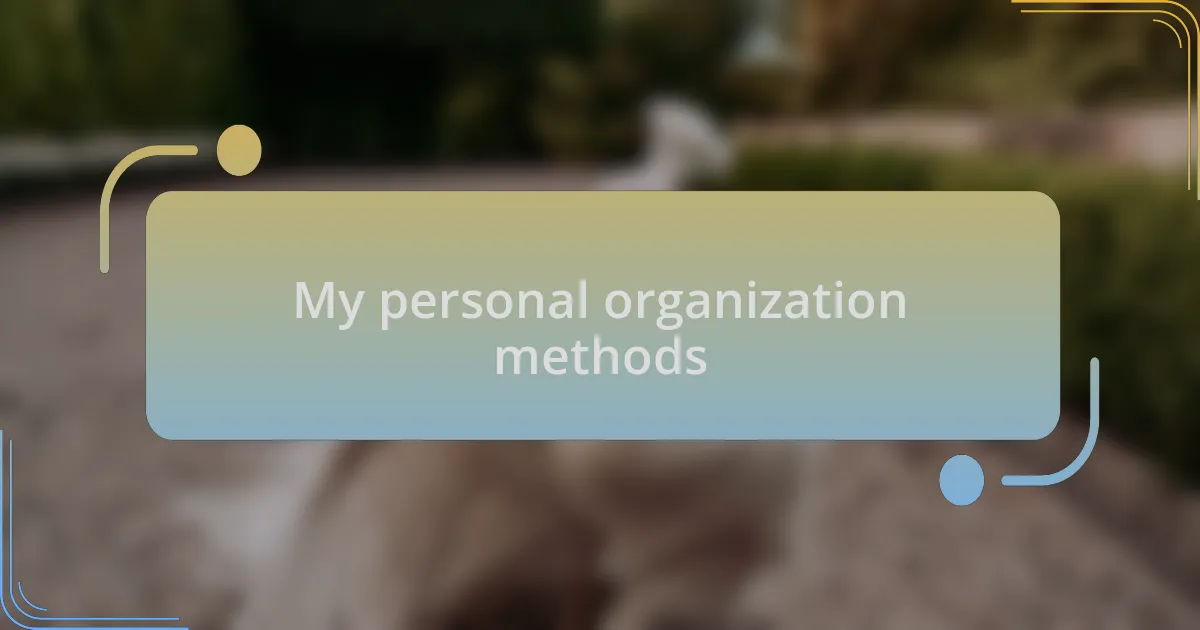
My personal organization methods
When it comes to my personal organization methods, I lean heavily on creating a structured naming system for all my files. Each film project has its own folder with a consistent format, allowing me to pinpoint what I need quickly. I recall a particularly chaotic production where I had to locate sound files amidst a mountain of documents. Thanks to my systematic approach, I found them in record time, which helped me stay ahead and maintain my composure, even under pressure.
Additionally, color coding is a game changer for me. I remember the thrill of finally implementing a color-coded system for my scripts and shot lists; it felt like unlocking a new level in a game. Each phase of production has its own designated color, which makes it visually clear where everything stands at a glance. Have you ever had to pour over endless files to figure out what’s what? This method transformed my workflow, allowing me to visualize tasks and maintain a clearer focus during hectic shooting days.
On days when creativity flows, I like to take a step back from digital tools and make physical lists on a large whiteboard. It was during one of those late-night brainstorming sessions that I realized how much I thrive on seeing everything laid out in front of me. The act of crossing off completed tasks feels incredibly rewarding and helps keep my mind engaged. Have you ever experienced that satisfaction of seeing your progress visually? It’s that tangible connection to the work that fuels my motivation and keeps the momentum going.
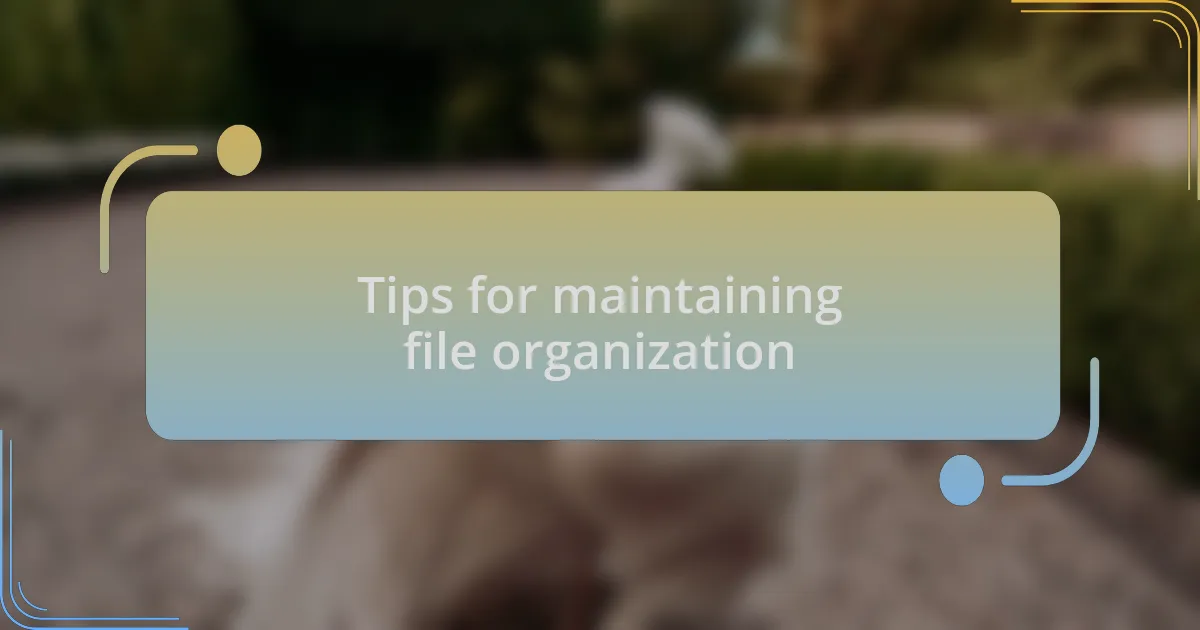
Tips for maintaining file organization
One key tip I’ve learned over the years is to regularly review and cleanse my project files. I recall a particularly overwhelming moment when I stumbled upon files I hadn’t touched in years. It hit me then how crucial it is to eliminate unnecessary clutter. By allocating time each month to sort through my folders, I not only streamline my workflow but also create mental space. Have you ever felt bogged down by old files? It’s amazing how liberating it is to let go.
I also find it incredibly helpful to create a ‘readme’ file within each project folder. This simple document serves as a guide to my own future self. I jot down what each file contains, any unique notes, and upcoming deadlines. During one frantic pre-production phase, I had to speedily reference logistics, and that readme saved my day. It’s like a quick roadmap that gets me right back on track. Doesn’t it feel good to have a personal assistant at your fingertips?
Lastly, investing in a robust backup system brings me peace of mind. I once lost hours of footage due to an unforeseen technical failure, and that taught me a crucial lesson: always prepare for the unexpected. Using cloud storage for quick access and local external drives for redundancy makes me feel secure. Have you ever lost something important because you weren’t backed up? It’s a horror story that I’ve resolved never to repeat.